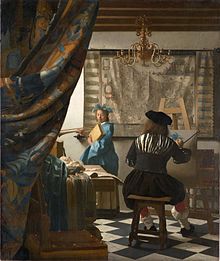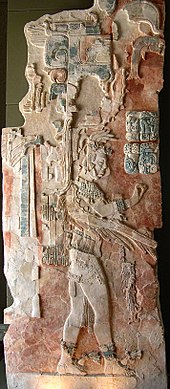Visual arts
![]()
This article is about the term. For the magazine of the same name, see Bildende Kunst (magazine).
![]()
Antike Kunst is a redirect to this article. For the magazine of the same name, see Antike Kunst (magazine).
The term fine arts has been established in the German-speaking world since the early 19th century as a collective term for the visually creative arts ("bildend" here means "shaping"). The genres of the fine arts originally included architecture, sculpture, painting, drawing, graphics and photography, as well as arts and crafts.
The visual arts are distinguished from the performing arts (such as theatre, dance and cinematography), literature and music. While the works of these other arts take place in a temporal sequence, a work of visual art usually exists as a physical-spatial entity that works through itself and does not require an interpreter to be perceived by the recipient. The visual arts and the other art forms mentioned can be grouped under the term "fine arts". This is especially common in other languages (e.g. French les beaux-arts, Italian le belle arti or English fine arts).
As a result of the development of new media and the progressive expansion of the concept of art in the 20th century, the term fine art is now much broader and can no longer be clearly distinguished from other art forms in individual cases. Thus, in the 20th and 21st centuries, the work of art, which until the beginning of modernism could be experienced primarily visually and often haptically, becomes process-oriented on a case-by-case basis, transforming itself, for example, into a pure idea or existing only as an instruction for action. Instead of a pure concept of genre, contemporary visual art is also defined by the art business and the art market, which includes established representatives of art criticism, the art trade, collectors, and art museums.
The subject of art in general education schools is about visual art. In some German federal states (e.g. Baden-Württemberg), the school subject is therefore called fine arts.

Landscape engraving by Dǒng Qíchāng (1555-1636)

Jan Vermeer: Allegory of Painting, 1666-1667
Development of the visual arts
Man's first works of art were expressions of religious ideas. Later, painting and sculpture were mostly commissioned art for religious institutions (in Europe the church), rulers, nobles or wealthy citizens. The motifs and imagery were often subject to strict conventions in most cultures. Perspective and other techniques radically changed art. The emergence of an art that no longer served any particular purpose as an end in itself (l'art pour l'art) in turn changed the relationship between artist, society, and artwork. In part, art became a site of utopias or took over tasks of religion.
Today, professional visual art is determined by a global art market. In Western countries, public funds or art venues such as museums are also increasingly being replaced by private-sector institutions and private foundations. Discussions about the contemporary concept of art are taking place in art criticism, art theory and at art academies. Since the 1990s, the art scene, which is concentrated primarily in Europe and North America, has been increasingly expanded by emerging countries such as Brazil, South Africa, Korea, or the Gulf States, which, for example, organize their own biennials.
Visual arts in other regions
Africa
When one speaks of African art, one is referring to the art of black Africa, which, like the rest of African culture, is distinct from the Arab north of the continent, the states of the Maghreb, and includes the artistic production of many very different ethnic groups. The peasant structures of Africa, which mainly produced wooden sculptures, the climatic conditions and a habitat that makes it easy for termites and other pests, have left almost no historical objects of traditional African art.
Since the artistic works of the then colonized continent have only been appreciated, researched and, above all, collected as objects of authentic cultures in Europe since the beginning of the 20th century, most of the works in museums and collections inside and outside Africa as well as on the art market are, with few exceptions, not older than 150 years.
Today outdated, discriminatory-sounding terms such as primitivism, Negro sculpture (Carl Einstein) or (in France) art negre were affirmative catchwords of Classical Modernism, which took the clear forms and timeless aura of African objects as its model.
America
For pre-Columbian art, see: Aztec, Chichimec, Huaxtec, Inca, Maya, Mixtec, Olmec, Purépecha (Tarasque), Toltec, Totonak, Zapotec, Chavín, Moche, Chimu, Recuay, Paracas, Nazca, Ica-Chincha, Chancay, Lima, Taíno, Marajó, Muisca, Narino, Tairona, Calima, Tolima, Sinu, Guinea.
Asia
- On the art of the equestrian peoples, see: Alans, Avars, Xiongnu, Huns, Cimmerians, Magyars, Massagets, Mongols, Parthians, Pechenegs, Polovtsians, Saks, Sarmatians, Scythians, Tatars.
- For Khmer art, see Angkor Wat.
- Chinese Art
- Japanese Art
- Korean Art
- Parthian Art
- Persian miniature painting

Image relief from Palenque, Mexico
Questions and Answers
Q: What are the visual arts?
A: The visual arts are art forms that create works which are mostly visual in nature.
Q: What do the visual arts produce?
A: The visual arts produce objects.
Q: How do the visual arts differ from the performing arts?
A: The visual arts are different from the performing arts.
Q: Can you provide examples of the visual arts?
A: Examples of the visual arts are ceramics, drawing, painting, sculpture, printmaking and poetry.
Q: Are modern visual arts included in this category?
A: Yes, modern visual arts which use technology such as photography, video, filmmaking and architecture are included in this category.
Q: Are there other types of art that involve aspects of the visual arts?
A: Yes, many artistic disciplines (performing arts, conceptual art, textile arts) involve aspects of the visual arts as well as arts of other types.
Q: Which other art forms are considered part of the visual arts?
A: The applied arts such as industrial design, graphic design, fashion design, interior design and decorative art are also considered part of the visual arts.
Search within the encyclopedia